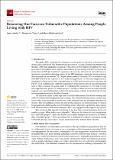| dc.contributor.author | Ayieko, James | |
| dc.contributor.author | Thorp, Marguerite | |
| dc.contributor.author | Ghebremichael, Musie | |
| dc.date.accessioned | 2024-11-27T16:54:32Z | |
| dc.date.available | 2024-11-27T16:54:32Z | |
| dc.date.issued | 2024-11-14 | |
| dc.identifier.uri | https://hdl.handle.net/1721.1/157688 | |
| dc.description.abstract | The global HIV landscape has changed over the past few decades, with great milestones achieved in both HIV treatment and prevention. Access to lifesaving antiretroviral therapy (ART) has markedly expanded, with a total of 30.7 million (27 million–31.9 million) out of 39.9 million (36.1 million–44.6 million) people living with HIV accessing the medication in 2023 [1]. Continued expansion of access to, initiation of, and adherence to treatment is crucial in achieving control of the HIV pandemic, given the strong evidence that treatment is prevention [2]. Despite these marked advances, 28% of people living with HIV (PLHIV) are reported to be virally unsuppressed [1]. Viral non-suppression is associated with increased risk of progression to AIDS and portends poor outcomes for PLHIV [3,4]. Additionally, viral non-suppression increases the risk of onward transmission of HIV, reversing the gains made in combating the pandemic [3]. The risk of viral non-suppression is greater in certain groups. This Special Issue focuses on exploring HIV support, care, and treatment for vulnerable populations, or those at elevated risk of viral non-suppression and poor health outcomes.
We solicited articles on this topic and received submissions from diverse settings and authors of different backgrounds and training. The interest and importance of this topic are revealed in the diversity of articles that were submitted and the disciplines that showed interest. This Special Issue contains ten articles that advance our understanding of vulnerable populations, challenge the current thinking about vulnerable populations, and propose bold interventions to address the barriers to HIV care engagement throughout the cascade.
The articles in this Special Issue bring to the fore three critical questions about vulnerable groups: What makes one vulnerable? What are the threats to care engagement for vulnerable people? And what health care system changes are needed to accommodate vulnerable people? These questions must be addressed to improve outcomes among vulnerable groups, especially to design interventions that address their concerns. | en_US |
| dc.publisher | Multidisciplinary Digital Publishing Institute | en_US |
| dc.relation.isversionof | http://dx.doi.org/10.3390/tropicalmed9110278 | en_US |
| dc.rights | Creative Commons Attribution | en_US |
| dc.rights.uri | https://creativecommons.org/licenses/by/4.0/ | en_US |
| dc.source | Multidisciplinary Digital Publishing Institute | en_US |
| dc.title | Renewing Our Focus on Vulnerable Populations Among People Living with HIV | en_US |
| dc.type | Article | en_US |
| dc.identifier.citation | Ayieko, J.; Thorp, M.; Ghebremichael, M. Renewing Our Focus on Vulnerable Populations Among People Living with HIV. Trop. Med. Infect. Dis. 2024, 9, 278. | en_US |
| dc.contributor.department | Ragon Institute of MGH, MIT and Harvard | en_US |
| dc.relation.journal | Tropical Medicine and Infectious Disease | en_US |
| dc.identifier.mitlicense | PUBLISHER_CC | |
| dc.eprint.version | Final published version | en_US |
| dc.type.uri | http://purl.org/eprint/type/JournalArticle | en_US |
| eprint.status | http://purl.org/eprint/status/PeerReviewed | en_US |
| dc.date.updated | 2024-11-26T17:42:57Z | |
| dspace.date.submission | 2024-11-26T17:42:57Z | |
| mit.journal.volume | 9 | en_US |
| mit.journal.issue | 11 | en_US |
| mit.license | PUBLISHER_CC | |
| mit.metadata.status | Authority Work and Publication Information Needed | en_US |
